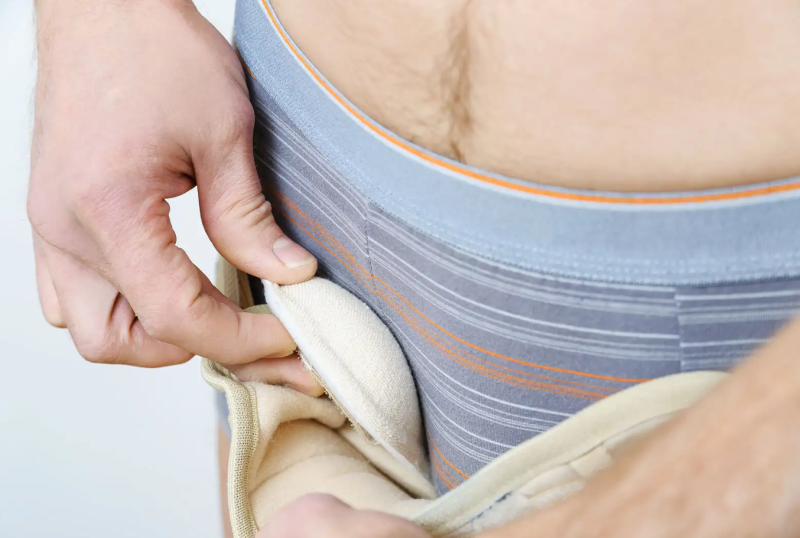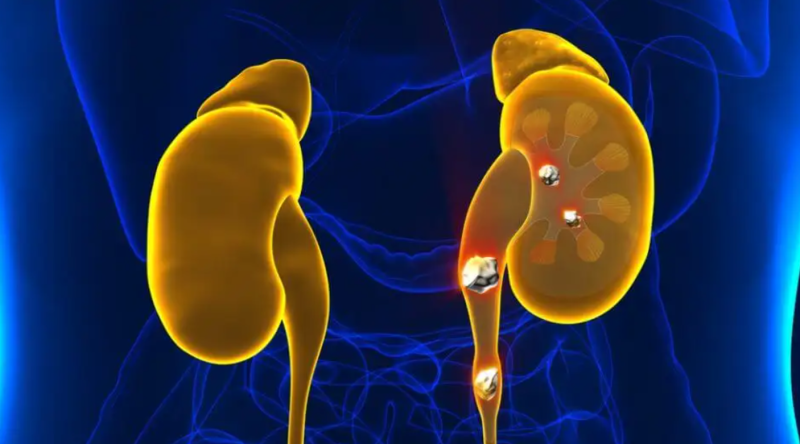
Groin pain is a common cause of discomfort for many people and can result from muscular, tendon, vascular, or nerve problems. In addition, certain diseases in internal organs can manifest with pain at this level.
In women, it can occur due to problems with pregnancy or as a result of inflammatory conditions, while in men, the origins are more diverse. Here are the 11 most common causes of groin pain.
Contents
The most common causes of groin pain
The groin or inguinal region is located in the highest part of the thighs, right at the junction with the pubic area and the abdomen. Through it runs the ligaments, muscles, nerves, and blood vessels that go to the scrotum and labia majora of the vagina.
Groin pain can come on suddenly after an injury, or it can come on gradually over weeks or months. It usually manifests itself as a stinging, burning, or persistent discomfort. The characteristics of the pain guide the clinician in the diagnosis. Some of the most common causes are as follows:
1. Groin hernia
Inguinal hernias occur when a small portion of the intestine protrudes through a hole in the abdominal wall. It is common for the hernia to follow the course of the inguinal canal and can be palpated through the testis. In advanced cases, the hernia comes out and displaces the scrotum.
This condition is a common cause of groin pain in men. Studies affirm that the pain is unilateral, sharp, and burning and extends to the thigh, lower back, and testicles. Most commonly, the pain comes on gradually and gets worse over time.
The discomfort is usually aggravated by coughing, leaning forward, carrying weight, or playing sports. Other common symptoms are:
- Discomfort when walking
- A lump that sticks out in the groin.
- The feeling of occupation and heaviness in the area.
Usually, the main complication is strangulation of the hernia. Some warning signs include fever, color changes in the area, and increased pain intensity. The repair of the hernia defect is performed surgically.

2. Muscle Strain
Muscle and tendon strain is one of the leading causes of groin pain. It is common in people who play high-impact sports for the lower limbs, such as hockey, soccer, and basketball. This discomfort is usually acute and worsens with movement.
In most cases, distension presents with swelling and redness of the groin. In addition, it is possible to show a bruise in the face of a direct blow. Fortunately, these types of injuries have a high recovery rate.
Some research suggests that the diagnosis of this type of injury is based on history and physical examination. The pain in a passive stretch of the injured muscle or during flexion against resistance is beneficial for detecting this discomfort. Imaging studies such as magnetic resonance imaging also help guide the diagnosis.
Medical treatment is based on rest and applying cold compresses in the region. In the same way, the professional may prescribe analgesics and non-steroidal anti-inflammatory drugs (NSAIDs) to reduce discomfort. In severe injuries, physiotherapy sessions may be necessary.
3. Orchitis and epididymitis
Orchitis is an inflammatory process of one or both testicles. It is usually the result of a bacterial infection or appears after a picture of mumps. Sometimes, it is associated with inflammation of the epididymis or epididymitis, the region of the testicle where sperm are stored.
Both pathologies are accompanied by pain and swelling in the groin and testicle. They present with fever, chills, malaise, nausea, and vomiting. In addition, the enlargement of the lymph nodes in the region can be evidenced, which would cause pain in the groin.
Fortunately, treating this type of pathology is straightforward; It is based on the use of analgesics and local measures such as the application of cold to reduce pain. The doctor will only recommend the use of antibiotics when the presence of a bacterial infection is confirmed.
4. Infectious processes
Bacterial infections at the level of the genitals are often accompanied by pain in the groin due to swollen lymph nodes. Such is the case with sexually transmitted diseases (STDs) such as syphilis and lymphogranuloma venereum.
Studies affirm that lymphogranuloma caused by chlamydia usually causes painful inguinal lymphadenopathy in the second stage of the disease. These infections require treatment with antibiotics and continuous supervision by a health professional.
5. Pregnancy
Pain in the groin during pregnancy is joint. It is usually more intense in the first and last trimester of pregnancy. It is due to the relaxation of the hip joints and the hormonal changes in the pregnant woman’s body that prepare her for childbirth.
In most cases, groin discomfort worsens with physical exertion, climbing stairs, lying on your back, and spreading your legs wide. Professionals recommend stretching exercises and using special underwear to reduce tension in the area.
During pregnancy, the likelihood of symphysis pubis dysfunction also increases. According to some studies, this condition begins as pelvic pain, which can radiate to the groin, thighs, and lower back. Treatment includes the use of pain relievers and therapies to reduce pain.
6. Ovarian cyst
Ovarian cysts are small, fluid-filled nodules that form inside or on the surface of the ovary. Some tend to go unnoticed and do not cause symptoms. However, larger lesions are accompanied by the following manifestations:
- Dull pain in the lower abdomen.
- Discomfort in the groin and pelvic floor.
- The sensation of abdominal heaviness.
- Fever and vomiting in severe cases.
- Swelling of the stomach.
The diagnosis is based on the clinic and imaging studies. Treatment depends on the size of the cyst and its evolution, so in some cases, expectant management is maintained. Similarly, the doctor may indicate oral contraceptives and surgery for large cysts or those suggestive of cancer.
7. Sciatic nerve injury
Pain caused by injury to the sciatic nerve is called sciatica. The most common causes include herniated discs and spinal compression.
These cause discomfort along the path of the sciatic nerve, which crosses the back and goes to the legs, passing through the pelvis, groin, and buttocks.
The pain can range from a burning or stinging sensation to an electric shock. It usually affects only one side of the body and is intensified by prolonged sitting, coughing, or sneezing.
8. Kidney stones
Pain associated with kidney stones is known as renal colic. It occurs when stones or calculi travel down the ureter into the bladder and urethra. There is severe pain, dark and cloudy urine, increased urinary frequency, and discomfort with urination.
Research suggests that typical renal colic pain radiates to areas supplied by the genitofemoral, ilioinguinal, and iliohypogastric nerves. This causes it to present in the lower back and spread as a wave to the lower abdomen, groin, thigh, and genitals.
Treatment is based on analgesics, antispasmodics, the destruction of stones by lithotripsy, and surgical removal.

9. Testicular torsion
Testicular torsion is a painful disorder caused by the rotation of the testicle on its axis with obstruction of blood flow to the scrotum. This condition is common in young men and presents with severe pain in the testicle and the groin on the same side, according to some studies.
Other symptoms are as follows:
- Nausea and vomiting.
- Scrotal swelling.
- Discomfort in the lower abdomen.
- Color change in the skin of the testicle.
- Increased frequency of urination.
It is common for the pain to suddenly wake the person up at night or in the morning. Diagnosis is based on symptoms and evaluation by imaging studies.
On the other hand, a surgical approach is necessary to correct the torsion. After 6 hours of the onset of the picture, the possibility of having to remove the testicle increases.
10. Osteoarthritis of the hip
Osteoarthritis or osteoarthritis is a degenerative condition that affects joint cartilage, which wears out asymmetrically in multiple joints. Cartilage wear usually generates clinical manifestations, depending on the affected joint.
The Spanish Society of Rheumatology suggests that the pain is in the groin in hip osteoarthritis, although it can go down the thigh and reach the knee. Treatment is aimed at stopping its progression, so exercises to strengthen muscles and drugs to improve pain should be performed.
11. Endometriosis
Endometriosis is when the endometrium proliferates in multiple regions outside the uterine cavity. This tissue can grow into the fallopian tubes, ovaries, and, in rare cases, the inguinal canal.
Endometrial growth in the inguinal canal is a rare condition that can manifest with groin pain exacerbated by menstruation, as suggested by some studies.
The treatment in these cases will be the surgical removal of the endometrial tissue outside the uterine body. It is also possible that hormonal therapy is started, after surgery, to prevent recurrences.
Other Possible Causes of Groin Pain
All the pathologies mentioned above are common causes of pain in the groin in both men and women. However, there are a large number of conditions that can also cause this symptom:
- Avascular necrosis of the femoral head.
- Urinary tract infections.
- Pelvic venous insufficiency.
- Hip sprains.
- Testicular masses.
- Retractile testicle.
- Bone fractures.
- Appendicitis.
- Varicocele.
- Hydrocele.
- Bursitis.
Causes of groin pain in Children
The causes of groin pain mentioned so far are more common in adults. Children can also manifest this symptom, although the origin may be due to other entities:
- Legg-Calve-Perthes disease is a pathology that affects the blood supply to the head of the femoral bone and its placement in the hip.
- Epiphysiolisthesis of the femoral head: occurs when the head of the femur slips on the growth plate or physis. This causes the bone to not articulate correctly in the hip and usually occurs after trauma.
- Dysplasia of the congenital development of the hip: there is an abnormal development of the coxofemoral joint, which favors the subluxation or dislocation of the joint and the consequent pain in the groin.
- Toxic synovitis: usually occurs after an upper respiratory pathology, such as tonsillitis and otitis. It is characterized by inflammation of the hip joint space and consequent pain.
- Juvenile idiopathic arthritis: consists of inflammation of multiple joints in children and adolescents. It can be one of the causes of groin pain when it affects the hip joint.
- Infectious arthritis: occurs when a bacterium colonizes and infects a joint. The hip joint may be affected, causing severe groin pain, fever, inability to walk, and other manifestations.
When is it necessary to see a doctor?
It is essential to go to the consultation if there is inguinal discomfort that does not disappear after a couple of days or increases in intensity. In addition, fever, vomiting, skin color changes, sweating, and loss of consciousness indicate greater severity.
Other conditions that warrant an urgent visit with the health care team include the following:
- Pain that does not improve after the use of analgesics.
- The presence of blood in the urine is associated with pain.
- Intense pain with no apparent origin in the testicles.
- Testicular inflammation together with systemic symptoms: fever, nausea, vomiting.
- Groin pain is associated with lower back, abdomen, or chest pain.
- Severe, intermittent pain in the lower abdomen that extends to the groin.
A symptom not to be taken lightly
A wide variety of conditions can cause groin pain. The most common causes in men include muscle strain, hernias, orchitis, and testicular torsion. On the other hand, in women, this symptom can appear during pregnancy or due to ovarian cysts and sexually transmitted diseases.
The ideal will always be to consult with the specialist as soon as possible, especially in intense pain of sudden appearance. This way, timely treatment of the condition can be initiated, and potential consequences can be avoided.